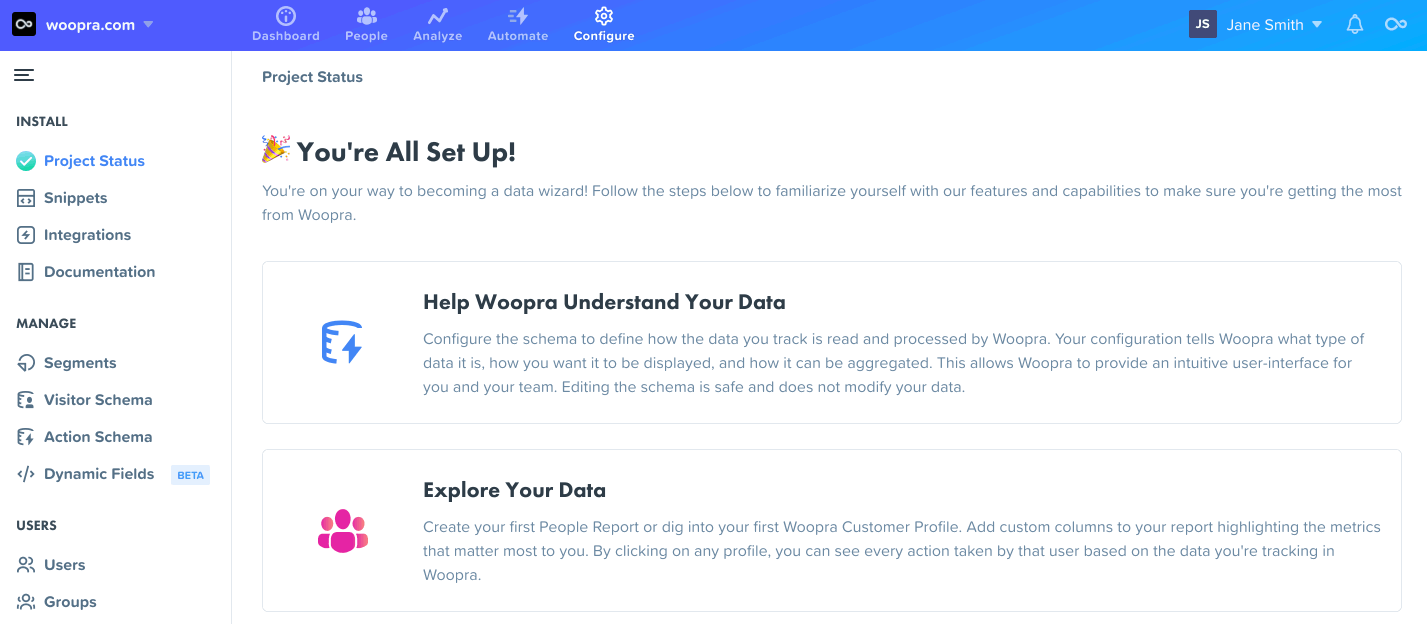Integrations
Most companies have snippets of customer interaction information spread all over the place. From email automation, to live chat clients, CRMs to support platforms, companies interact with and engage their customers in many ways from many different sources. To get a full picture of customer engagement across all of these different tools, teams spend much of their time looking at siloed snapshots and piecing them together into a full picture of their users.
Woopra Integrations is a one-of-a-kind feature, which solves this industry-wide problem by instantly connecting Woopra to other tools in a matter of seconds. This greatly enriches the data from tracking custom events and identifying customers on the website or application with Woopra’s SDKs.
Integrations’ tight connections with CRMs, help desks, email automation systems, live chat tools, and more, allows users to take control of their data, centralizing it in a single platform.
Woopra’s Integrations are set up in two parts:
- Snippets give you multiple SDKs to install on the website or app so the user can start tracking event with Woopra. Snippets include SDKs for Javascript, Android, iOS, Node.js, Python, Java, and PHP.
- Integrations – Integrations are the external Apps that users can connect to Woopra in just a few clicks.

Setting up Integrations
Integrations are super easy to set up; most of them can be installed with just a few clicks. Users can find Integrations under the Configure module/tab on the dashboard. Once installed and authorized (where necessary), the different apps instantly sync events from within the given tool to Woopra. The user will be able to use these events immediately throughout Woopra.
For example, one can leverage Integrations’ events as a segmentation filter option in the Profile Reports. In addition, they can use them to set up a step in the Journey report.
In addition to bringing data into Woopra, some apps also enable users to trigger events in other tools to create more personalized and relevant customer experiences.
Other apps allow automated scheduling of important reports to different tools so that all teams can easily access important reports from a single location without requiring different authorizations or permissions in the many different products.
Set Up the Apps
First, go to the Configure section in Woopra’s navigation bar. Select the Integrations icon from the sidebar to access the applications. Click on the app of interest to set it up. Click “Install” in the upper right corner and follow the instructions to authorize the app according to the permissions of the tool.
Once installed and authorized, select the Setup page to ensure that the tracking of interest is selected. Different apps will allow for enabling or disabling certain features from this page, so be certain to check for more information.
Working With Integrations
After installation, any application events automatically sent or defined by the setup will instantly become available in segmentation filters and Segments throughout all Woopra’s reports as well as event filters in Journeys, Trends, and Retention reports.
To use Integrations Trigger events, open the ‘Automate’ section, and select ‘Triggers’ on the sidebar. Configure the conditions that are wished to trigger the event for, select an App Event from the ‘Add Event’ options, and define the conditions appropriately. Click “Create” to save your setup.
To schedule report uploads to the tool of interest, choose to upload your Analytics reports to the app target by selecting the tool name from the scheduled tasks options. Configure the specific destination you want to send the reports to and the format that you’d like the report to be sent in. Click “Create” to save your setup.
Use Cases
Integrations are entirely unique in their ability to bring all of the data together into a single hub, where the user can then analyze and automate events based on a comprehensive picture of their customer’s interactions, responses to email campaigns, onsite surveys, chat efforts and so on.
Let’s consider a few examples; Using the Zendesk App, a SaaS company may set up a trigger to upgrade ticket status when a customer experiences any kind of error. The recently submitted ticket of a high profile customer could be automatically upgraded to urgent, allowing for faster response times.
Another example might be an online game company, whose support team closely monitors player activity for any potential abuse. They might make good use of the Hipchat app, which installs a trigger event that allows the user to post custom messages to the Hipchat channels when a given event occurs. This company might set up a trigger to alert the moderators immediately when there may be questionable activity.
In another example, a sales representative might schedule an upload for a weekly report on new signups, which is automatically shared with product and sales teams, or upload a monthly report on Adwords performance, to be shared with the marketing team and an outside agency.
Updated 2 months ago
